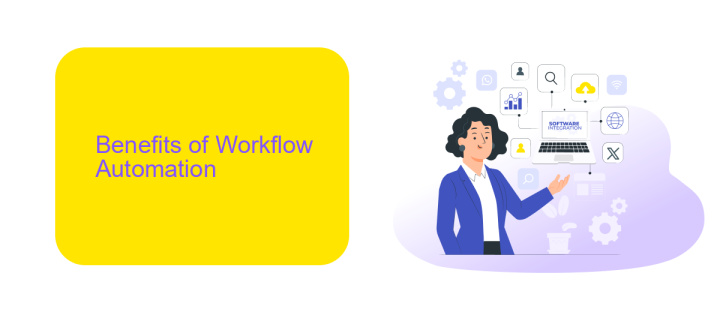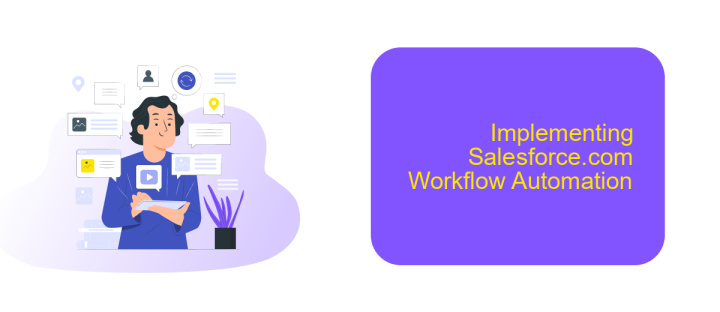Salesforce.com Workflow Automation
Salesforce.com Workflow Automation revolutionizes the way businesses manage their processes by streamlining repetitive tasks and enhancing efficiency. This powerful tool enables organizations to automate workflows, reduce manual errors, and ensure consistency across various operations. By leveraging Salesforce's robust platform, companies can focus more on strategic initiatives and less on routine administrative duties, ultimately driving growth and improving overall productivity.
Introduction
Salesforce.com Workflow Automation is a powerful tool that enables businesses to streamline their processes and enhance productivity. By automating routine tasks and workflows, organizations can focus on more strategic initiatives and reduce the risk of human error. This technology is particularly beneficial for sales and customer service teams, who can leverage it to improve their efficiency and response times.
- Automate repetitive tasks
- Enhance team productivity
- Reduce human error
- Improve customer response times
One of the key features of Salesforce.com Workflow Automation is its ability to integrate with various third-party services, such as ApiX-Drive. ApiX-Drive simplifies the process of setting up integrations by providing an easy-to-use platform that connects Salesforce with other applications. This enables seamless data flow and ensures that all your tools work together harmoniously, further enhancing your workflow efficiency.
Benefits of Workflow Automation

Workflow automation in Salesforce.com offers numerous benefits that significantly enhance business operations. By automating repetitive tasks, businesses can save valuable time and resources, allowing employees to focus on more strategic activities. This not only increases productivity but also reduces the likelihood of human error, ensuring processes are executed consistently and accurately. Furthermore, automation enables better tracking and reporting, providing real-time insights into workflow performance and helping to identify areas for improvement.
Another key advantage of workflow automation is the seamless integration with other tools and services. For instance, using platforms like ApiX-Drive, businesses can easily connect Salesforce with various applications, streamlining data transfer and communication between systems. This integration capability ensures that all relevant information is synchronized across platforms, reducing data silos and enhancing overall efficiency. Consequently, businesses can achieve a more cohesive and interconnected operational environment, driving better decision-making and fostering growth.
Salesforce.com Workflow Automation Features

Salesforce.com Workflow Automation offers a robust suite of features designed to streamline and optimize business processes. By automating repetitive tasks, businesses can save time and reduce the potential for human error, thereby enhancing overall productivity.
- Task Automation: Automatically assign and track tasks based on predefined criteria.
- Email Alerts: Send automated email notifications to relevant stakeholders upon specific triggers.
- Field Updates: Automatically update field values in records to maintain data consistency.
- Approval Processes: Streamline approval workflows with automated routing and notifications.
- Integration with ApiX-Drive: Seamlessly connect Salesforce with other applications to automate data transfer and synchronization.
These features enable businesses to create customized workflows that align with their unique requirements. By leveraging tools like ApiX-Drive, companies can further enhance their workflow automation capabilities, ensuring seamless integration with various third-party applications. This not only improves operational efficiency but also allows for better data management and decision-making.
Implementing Salesforce.com Workflow Automation

Implementing Salesforce.com workflow automation can significantly enhance your business processes by streamlining repetitive tasks and reducing manual effort. To begin, clearly define the specific workflows you want to automate, such as lead management, customer follow-ups, or data entry.
Once you have identified the workflows, configure Salesforce.com to automate these processes. This involves creating workflow rules, defining criteria, and setting up actions like email alerts, task creation, or field updates. Ensure that your criteria are precise to avoid unnecessary triggers.
- Define workflow rules and criteria
- Set up actions like email alerts, task creation, and field updates
- Test workflows to ensure they function as expected
- Utilize integration tools like ApiX-Drive for seamless data transfer
Testing is crucial to ensure that your workflows operate correctly and meet your business needs. Additionally, consider using integration tools such as ApiX-Drive to connect Salesforce with other applications, enabling seamless data flow and further automating your processes. By carefully planning and implementing these steps, you can optimize your Salesforce.com workflows for maximum efficiency.
- Automate the work of an online store or landing
- Empower through integration
- Don't spend money on programmers and integrators
- Save time by automating routine tasks
Best Practices for Salesforce.com Workflow Automation
To effectively implement Salesforce.com workflow automation, it is crucial to start with a clear understanding of your business processes. Map out each step to identify the tasks that can be automated, ensuring you focus on high-impact areas that save time and reduce errors. Utilize Salesforce's built-in tools like Process Builder, Flow, and Workflow Rules to create seamless automation. These tools allow you to automate repetitive tasks, send automatic email alerts, and update records without manual intervention.
Another best practice is to integrate Salesforce with other applications to enhance workflow efficiency. Services like ApiX-Drive can help you set up these integrations effortlessly. ApiX-Drive enables you to connect Salesforce with various third-party applications, ensuring data consistency and streamlined processes. Regularly review and optimize your workflows to adapt to changing business needs and leverage Salesforce’s updates and new features. Monitoring and analyzing the performance of your automations will help you identify areas for improvement and ensure your workflows remain efficient and effective.
FAQ
What is Salesforce Workflow Automation?
How can I create a workflow rule in Salesforce?
What are the benefits of using workflow automation in Salesforce?
Can I integrate Salesforce with other applications for automation purposes?
What is Salesforce Flow and how is it different from Workflow Rules?
Do you want to achieve your goals in business, career and life faster and better? Do it with ApiX-Drive – a tool that will remove a significant part of the routine from workflows and free up additional time to achieve your goals. Test the capabilities of Apix-Drive for free – see for yourself the effectiveness of the tool.


